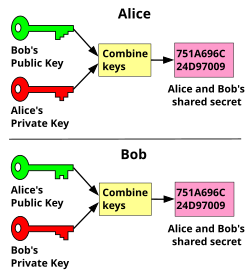A key agreement algorithm published in 1976 by Whitfield Diffie and Martin Hellman. Diffie-Hellman does key establishment, not encryption. However, the key that it produces may be used for encryption, for further key management operations, or for any other cryptography.
Diffie–Hellman key exchange is a method of securely exchanging cryptographic keys over a public channel and was one of the first public-key protocols as conceived by Ralph Merkle and named after Whitfield Diffie and Martin Hellman. DH is one of the earliest practical examples of public key exchange implemented within the field of cryptography. Published in 1976 by Diffie and Hellman, this is the earliest publicly known work that proposed the idea of a private key and a corresponding public key.

Traditionally, secure encrypted communication between two parties required that they first exchange keys by some secure physical means, such as paper key lists transported by a trusted courier. The Diffie–Hellman key exchange method allows two parties that have no prior knowledge of each other to jointly establish a shared secret key over an insecure channel. This key can then be used to encrypt subsequent communications using a symmetric key cipher.
Diffie–Hellman is used to secure a variety of Internet services. However, research published in October 2015 suggests that the parameters in use for many DH Internet applications at that time are not strong enough to prevent compromise by very well-funded attackers, such as the security services of some countries.
The scheme was published by Whitfield Diffie and Martin Hellman in 1976, but in 1997 it was revealed that James H. Ellis,Clifford Cocks, and Malcolm J. Williamson of GCHQ, the British signals intelligence agency, had previously shown in 1969 how public-key cryptography could be achieved.
Although Diffie–Hellman key agreement itself is a non-authenticated key-agreement protocol, it provides the basis for a variety of authenticated protocols, and is used to provide forward secrecy in Transport Layer Security's ephemeral modes (referred to as EDH or DHE depending on the cipher suite).
The method was followed shortly afterwards by RSA, an implementation of public-key cryptography using asymmetric algorithms.
Expired U.S. Patent 4,200,770 from 1977 describes the now public-domain algorithm. It credits Hellman, Diffie, and Merkle as inventors.


